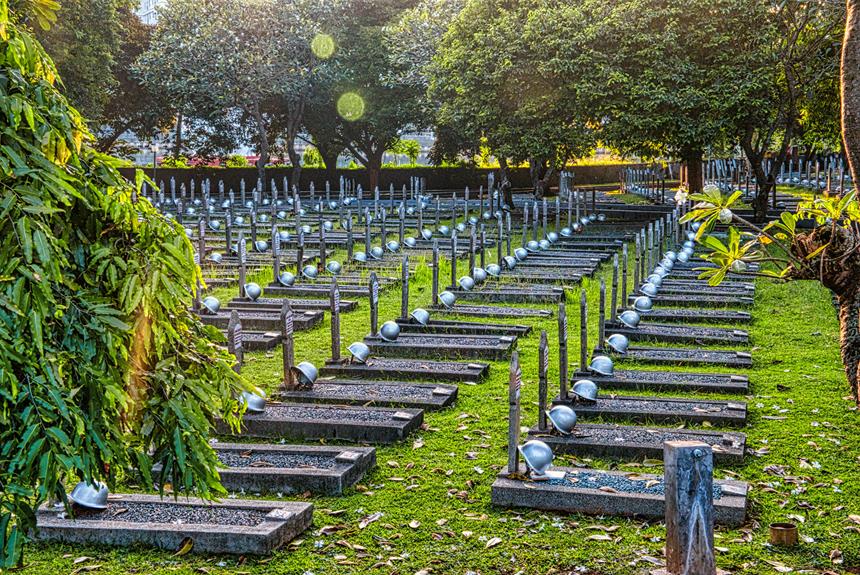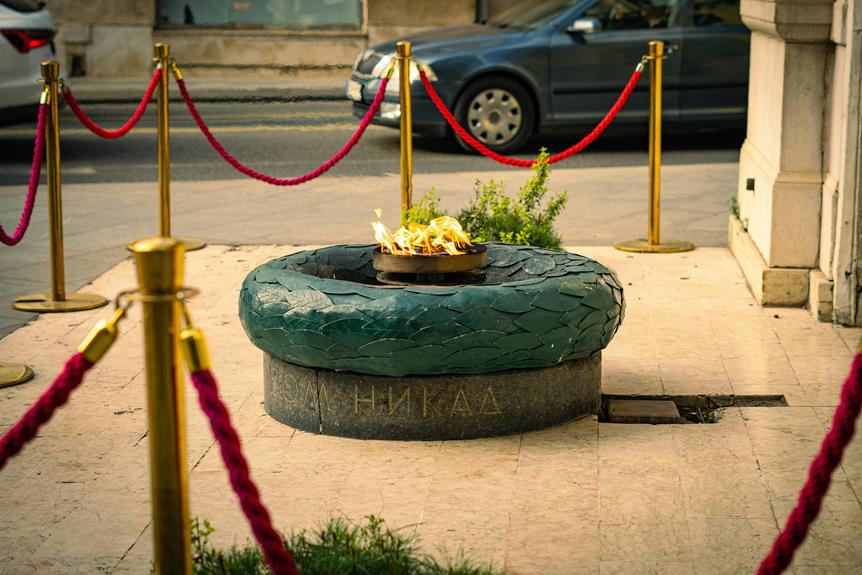Nestled in the heart of Addis Ababa, the Red Terror Martyrs' Memorial Museum in Ethiopia stands as a solemn reminder of a dark chapter in the country's history. As visitors walk through its halls, they are confronted with the harrowing stories of those who suffered at the hands of brutality and oppression. The museum's mission goes beyond mere remembrance; it challenges us to confront uncomfortable truths and grapple with the complexities of justice and reconciliation. The narratives woven within its walls beckon us to confront the past, prompting introspection and contemplation of the impact of historical memory on present-day society.
Key Takeaways
- Immersive journey through Ethiopia's history.
- Interactive displays engage visitors effectively.
- Educational resources offer detailed Red Terror overview.
- Promotes human rights and historical memory.
- Space for reflection on lasting societal impact.
History of the Red Terror
The Red Terror in Ethiopia, a period of political repression and mass killings orchestrated by the Derg regime in the late 1970s, left a deep and lasting impact on the country's history and society. The origins of this dark chapter can be traced back to the Marxist military junta led by Mengistu Haile Mariam, which overthrew Emperor Haile Selassie in 1974. What began as a campaign to eliminate political opponents and counter-insurgents quickly escalated into widespread violence and terror, resulting in the deaths of an estimated 500,000 people.
The atrocities committed during the Red Terror were characterized by systematic brutality, including arbitrary arrests, torture, and executions carried out by security forces and party cadres. The regime's goal was to suppress dissent, instill fear, and consolidate power through violence and intimidation. Thousands of innocent civilians, intellectuals, students, and suspected dissidents were targeted, leading to a climate of fear and distrust that permeated Ethiopian society.
The Red Terror not only claimed countless lives but also fractured communities, destroyed families, and traumatized a generation. The scars of this period continue to haunt Ethiopia, shaping its political landscape and social fabric. Understanding the history of the Red Terror is essential to grasp the complexities of Ethiopia's past and the ongoing struggles for justice, reconciliation, and freedom in the country.
Museum Exhibits and Artifacts
How do the museum exhibits and artifacts at the Red Terror Martyrs' Memorial Museum in Ethiopia provide insight into the atrocities committed during the Red Terror period?
The museum's displays offer a poignant and immersive experience, allowing visitors to engage with the history of the Red Terror through interactive displays and personal stories. Here are some ways in which the exhibits and artifacts shed light on the dark chapter of Ethiopia's past:
- Personal Belongings: The museum showcases personal belongings of the victims, such as clothing, letters, and photographs, humanizing the tragedy and connecting visitors to the individuals who suffered during this period.
- Audiovisual Testimonies: Visitors can listen to audio recordings and watch video testimonies of survivors and witnesses, providing a firsthand account of the horrors endured and ensuring that the victims' stories are not forgotten.
- Artistic Representations: Artifacts like paintings and sculptures depict the emotions and struggles of those affected by the Red Terror, offering a creative and emotional insight into the impact of the atrocities.
- Interactive Displays: The museum features interactive displays that enable visitors to explore different aspects of the Red Terror, encouraging a deeper understanding of the historical events and their significance.
- Archival Documents: Exhibits include archival documents such as newspapers, government reports, and historical records, offering a detailed view of the political climate and human rights violations that occurred during the Red Terror.
Commemorating the Victims
Incorporating symbolic tributes and memorial structures, the Red Terror Martyrs' Memorial Museum in Ethiopia honors the victims of the atrocities committed during the Red Terror period. The museum serves as a poignant reminder of the suffering endured by countless Ethiopians during this dark chapter in history. Through victims' stories displayed within the museum, visitors are confronted with the harrowing realities of the past, guaranteeing that the memory of those who perished is preserved for future generations.
In addition to static exhibits, the museum organizes memorial events to commemorate the victims and provide a space for reflection and healing. These events often include ceremonies, speeches, and gatherings where families and survivors can come together to honor the memories of their loved ones. By actively engaging with the community in these ways, the museum fosters a sense of solidarity and unity in the face of past traumas.
The Red Terror Martyrs' Memorial Museum stands as a validation to the resilience of the Ethiopian people and their unwavering commitment to justice and remembrance. It serves not only as a repository of historical artifacts but as a living memorial that ensures the victims are never forgotten. Through commemorating the victims with dignity and respect, the museum plays an essential role in the healing process and the preservation of collective memory.
Impact on Ethiopian Society
The Red Terror Martyrs' Memorial Museum in Ethiopia encapsulates a powerful representation of historical reckoning that profoundly influences contemporary Ethiopian society. The impact of this memorial museum extends beyond just commemorating the victims; it plays a pivotal role in fostering social healing and national reconciliation.
- Fostering Collective Memory: The museum serves as a living memory of the atrocities committed during the Red Terror period, ensuring that future generations remember the past and learn from it.
- Promoting Dialogue: By providing a space for dialogue and reflection, the museum encourages open discussions about Ethiopia's history, fostering understanding and empathy among its citizens.
- Encouraging Accountability: Through its exhibitions and educational programs, the museum highlights the importance of accountability for past wrongs, promoting a culture of justice and transparency.
- Inspiring Activism: Visitors to the museum are often moved to take action against injustice and inequality, sparking grassroots movements for positive change in Ethiopian society.
- Building Solidarity: The museum brings together individuals from diverse backgrounds, fostering a sense of unity and solidarity among Ethiopians as they confront their shared past and work towards a common future.
In essence, the Red Terror Martyrs' Memorial Museum serves as a beacon of hope for social healing and national reconciliation in Ethiopia, reminding its people of the importance of confronting the past to build a more just and peaceful society.
Visiting the Memorial Museum
Upon entering the Red Terror Martyrs' Memorial Museum in Ethiopia, visitors are immediately immersed in a poignant and thought-provoking journey through the country's tumultuous history. The museum serves as a sobering reminder of the atrocities committed during the Red Terror period, offering a space for reflection and remembrance. The museum's design and layout are carefully curated to evoke emotional responses from visitors and provide a thorough understanding of the events that transpired.
One of the striking features of the museum is its interactive displays, which allow visitors to engage with the exhibits in a hands-on manner. These interactive elements help bring the history to life and create a more engaging experience for visitors. By actively participating in the learning process, visitors can develop a deeper connection to the stories of the victims and gain a greater appreciation for the importance of preserving historical memory.
In addition to its interactive displays, the Red Terror Martyrs' Memorial Museum offers a wealth of educational resources for visitors seeking to learn more about Ethiopia's history. From archival documents and photographs to personal testimonies and artifacts, the museum provides a detailed overview of the Red Terror period and its lasting impact on Ethiopian society. Overall, a visit to the museum is not only educational but also serves as a powerful reminder of the importance of upholding human rights and preserving the memory of those who lost their lives during this dark chapter in history.
Frequently Asked Questions
How Can I Support Ongoing Efforts to Preserve the Memory of the Red Terror Martyrs?
To support ongoing efforts to preserve the memory of the Red Terror martyrs, individuals can donate funds to aid in the maintenance and expansion of memorial sites.
Additionally, volunteering time to assist with educational programs or events can help raise awareness and guarantee the stories of the victims are not forgotten.
Are There Any Special Events or Ceremonies Held at the Museum?
Cultural celebrations and annual commemorations are essential components of any memorial site's programming. These events offer opportunities to honor and remember the significance of historical events, fostering a sense of unity and remembrance within a community.
Such ceremonies serve as poignant reminders of the sacrifices made by those who came before us, highlighting the importance of preserving collective memory for future generations.
Can Visitors Contribute Personal Stories or Artifacts to the Museum Collection?
Visitors often seek to enrich museum collections with personal contributions, fostering a sense of connection and community engagement. These artifacts add layers of meaning, enhancing the historical narrative and providing diverse perspectives.
However, museums must meticulously assess each item to guarantee relevance, authenticity, and ethical considerations. Personal contributions can enrich the museum experience, turning static displays into dynamic, living testimonies of shared human experiences.
Is There a Way to Virtually Tour the Red Terror Martyrs Memorial Museum?
Virtual tours have become increasingly popular, offering visitors the opportunity to explore museums and cultural sites from the comfort of their homes. Through interactive exhibits, users can immerse themselves in the history and significance of these locations.
This digital format allows for a dynamic and engaging experience, providing access to a wide audience who may not be able to visit in person. It also opens up new possibilities for education and cultural exchange.
Are There Educational Programs or Resources Available for Students and Researchers?
When exploring educational programs and research resources, it is important to take into account their depth and breadth. Educational programs should offer diverse perspectives, engaging materials, and interactive elements to facilitate learning.
Similarly, research resources should be thorough, reliable, and accessible to enable thorough investigation and analysis. Striking a balance between structured learning experiences and open-ended exploration can enhance the educational journey for students and researchers alike.
Conclusion
To sum up, the Red Terror Martyrs' Memorial Museum in Ethiopia serves as a compelling demonstration of the atrocities committed during the Red Terror period. Through its exhibits and artifacts, it sheds light on a dark chapter in Ethiopian history, reminding us of the importance of remembering past injustices.
The museum's impact on Ethiopian society is profound, fostering dialogue and activism against injustice. In the face of such tragedy, the museum stands as a beacon of hope, urging us to never forget.


